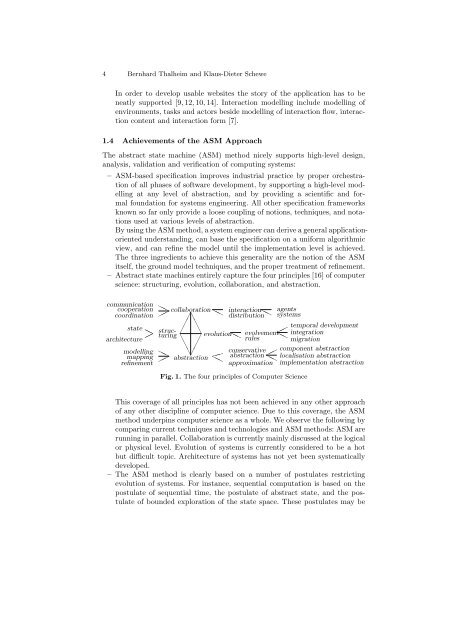BPMN and Beyond Business process modelling notation, workflow ...
BPMN and Beyond Business process modelling notation, workflow ...
BPMN and Beyond Business process modelling notation, workflow ...
You also want an ePaper? Increase the reach of your titles
YUMPU automatically turns print PDFs into web optimized ePapers that Google loves.
4 Bernhard Thalheim <strong>and</strong> Klaus-Dieter Schewe<br />
In order to develop usable websites the story of the application has to be<br />
neatly supported [9, 12, 10, 14]. Interaction <strong>modelling</strong> include <strong>modelling</strong> of<br />
environments, tasks <strong>and</strong> actors beside <strong>modelling</strong> of interaction flow, interaction<br />
content <strong>and</strong> interaction form [7].<br />
1.4 Achievements of the ASM Approach<br />
The abstract state machine (ASM) method nicely supports high-level design,<br />
analysis, validation <strong>and</strong> verification of computing systems:<br />
– ASM-based specification improves industrial practice by proper orchestration<br />
of all phases of software development, by supporting a high-level <strong>modelling</strong><br />
at any level of abstraction, <strong>and</strong> by providing a scientific <strong>and</strong> formal<br />
foundation for systems engineering. All other specification frameworks<br />
known so far only provide a loose coupling of notions, techniques, <strong>and</strong> <strong>notation</strong>s<br />
used at various levels of abstraction.<br />
By using the ASM method, a system engineer can derive a general applicationoriented<br />
underst<strong>and</strong>ing, can base the specification on a uniform algorithmic<br />
view, <strong>and</strong> can refine the model until the implementation level is achieved.<br />
The three ingredients to achieve this generality are the notion of the ASM<br />
itself, the ground model techniques, <strong>and</strong> the proper treatment of refinement.<br />
– Abstract state machines entirely capture the four principles [16] of computer<br />
science: structuring, evolution, collaboration, <strong>and</strong> abstraction.<br />
communication<br />
cooperation<br />
coordination<br />
state<br />
❍✟<br />
architecture<br />
<strong>modelling</strong><br />
mapping<br />
refinement<br />
❍❍<br />
✟✟<br />
structuring<br />
❍❍<br />
✟✟<br />
collaboration ❍❍ interaction<br />
distribution ❍ agents systems<br />
✁ ✁✁<br />
❆<br />
❆<br />
❆ evolution<br />
❆ ✁<br />
❍❍ evolvement ✟ temporal development<br />
❍ integration<br />
rules<br />
migration<br />
❆❆ ✁<br />
✁ conservative component abstraction<br />
✘✘<br />
abstraction abstraction ✟✟<br />
❍❍<br />
❍❍ localisation abstraction<br />
approximation implementation abstraction<br />
Fig. 1. The four principles of Computer Science<br />
This coverage of all principles has not been achieved in any other approach<br />
of any other discipline of computer science. Due to this coverage, the ASM<br />
method underpins computer science as a whole. We observe the following by<br />
comparing current techniques <strong>and</strong> technologies <strong>and</strong> ASM methods: ASM are<br />
running in parallel. Collaboration is currently mainly discussed at the logical<br />
or physical level. Evolution of systems is currently considered to be a hot<br />
but difficult topic. Architecture of systems has not yet been systematically<br />
developed.<br />
– The ASM method is clearly based on a number of postulates restricting<br />
evolution of systems. For instance, sequential computation is based on the<br />
postulate of sequential time, the postulate of abstract state, <strong>and</strong> the postulate<br />
of bounded exploration of the state space. These postulates may be
















